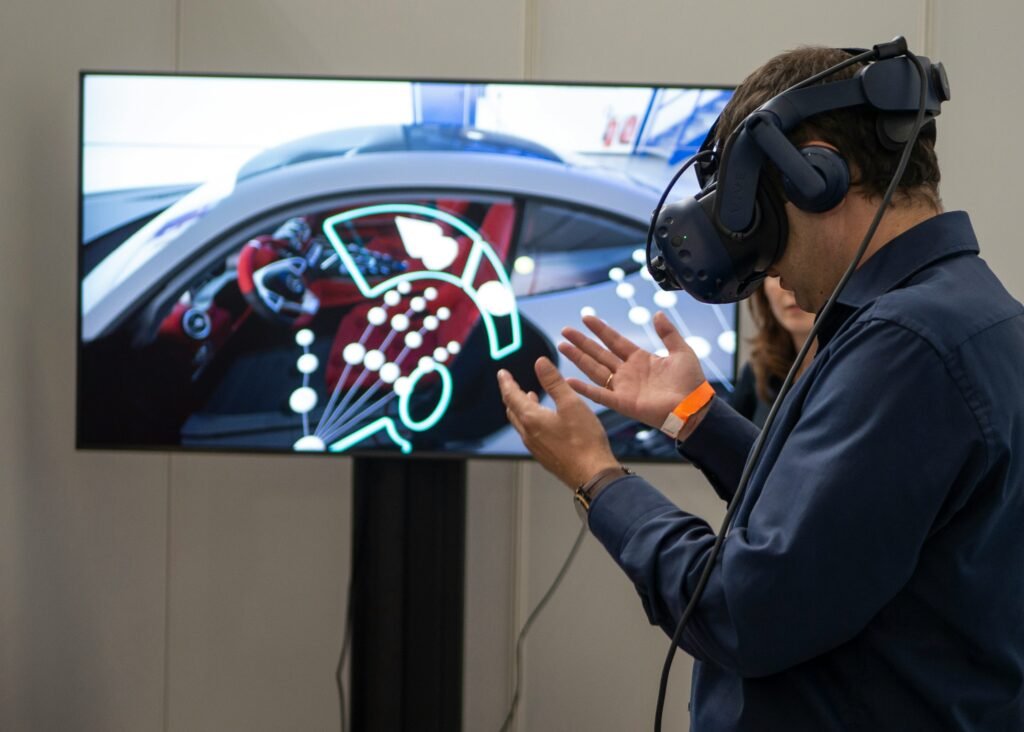
2024 is a year in which technological progress can actually be described as unprecedented, with innovation happening faster than ever. From the rise of Quantum Computing to breakthroughs in AI-driven personalization, change in the tech landscape happens faster than ever. With the year deepening further and further, it becomes crucial that one stays updated about the Tech Trends unfolding.
In this post, we’ll look at five rising technology trends that are reshaping the future and causing considerable change across industries. These trends are not simply ideas for the future; they are changing the way we live, work, and interact with our surroundings. Understanding these breakthroughs can help you navigate the fast-paced world of technology and take advantage of new developments.
AI-Driven Personalization

By 2024, AI-driven customization has advanced beyond simple recommendations to deliver profoundly individualized experiences across a wide range of businesses. Using massive volumes of data, artificial intelligence is now crucial in anticipating consumer wants, generating content, and offering services that resonate on an individual level. This movement is altering the digital landscape, making interactions more intuitive and personalized for each user.
Impact on Consumer Expectations and Business Strategies
As AI evolves, so are customer expectations. Today’s users expect experiences that are tailored to their specific interests and behaviors, rather than generic solutions. This shift is forcing organizations to reconsider their strategies, incorporating AI to provide individualized interactions at each stage of the consumer journey.
AI-driven modifying enables firms to establish a stronger relationship with their target audience. Companies that analyze client data in real time can forecast requirements before they occur, offer items that exactly match individual preferences, and even adjust marketing messages to personal purchasing habits. This level of modification not only improves user pleasure, but also increases engagement and loyalty, offering businesses a competitive advantage in a busy market.
Examples of AI Personalization in Action
Retail:
Companies such as Stitch Fix are transforming the fashion industry by utilizing artificial intelligence to provide tailored apparel recommendations. The software selects clothing based on user preferences, body measurements, and style selections.
Streaming Services:
Netflix and Spotify have established a standard for customized content. Their AI algorithms evaluate viewing and listening patterns to recommend movies, episodes, and playlists that perfectly match to a user’s preferences, making entertainment more engaging.
Healthcare:
AI-powered personalization is transforming the healthcare industry. Platforms such as Zebra Medical Vision employ artificial intelligence to analyze medical images and provide individualized medical knowledge, allowing doctors to provide more accurate and targeted therapies.
Why AI Personalization Matters
The rise of AI-driven personalization is more than simply a trend it represents a fundamental shift in how organizations interact with customers. As variation becomes the standard, firms that do not adapt risk falling behind. By integrating AI, organizations may provide more meaningful interactions, strengthen consumer relationships, and ultimately achieve greater success in a technologically driven society.
Quantum Computing Breakthroughs

Quantum computing is a fascinating discovery in 2024 that has the potential to revolutionize data processing. Unlike traditional computers, which employ “bits” (small switches that are either on or off), quantum computers use “qubits,” which can be in several states at once. This makes quantum computers extremely powerful, capable of solving complicated problems far faster than modern computers.
Impact on Key Industries
Quantum computing could have a big impact in several important areas:
Finance:
Quantum computers could help financial professionals make better predictions by quickly checking massive volumes of data, resulting in more informed investment decisions.
Healthcare:
In medicine, quantum computing has the potential to accelerate the discovery of novel medications and produce treatments personalized to specific individuals, thereby improving health outcomes.
Cybersecurity:
While quantum computing has the potential to improve security by producing greater encryption, it may potentially damage present security measures, forcing the development of new protections.
Recent Developments and Leading Companies
Google:
Google has made headlines with a quantum computer that can solve problems no regular computer can handle, marking a major step forward.
IBM:
IBM is another market leader in this area, providing quantum computing tools that businesses can use to test new applications.
D-Wave Systems:
D-Wave focuses on applying quantum computing to real-world challenges, such as optimizing logistics routes and enhancing manufacturing processes.
Why Quantum Computing Matters
Quantum computing is more than just a new type of computer; it has the potential to revolutionize industries by solving problems that are too complex for current technology. Understanding these discoveries can provide an insight into the future of technology.
5G Expansion and Beyond

5G technology will make waves in 2024, bringing in a new era of faster, more reliable internet connectivity. This next-generation mobile network is more than just a jump in speed; it serves as the platform for future advancements. As we move ahead, early discussions regarding 6G are gaining speed, pointing to even greater advances in connectivity.
Impact on Connectivity and Smart Cities
Enhanced Mobile Connectivity:
5G provides considerably faster speeds and lower latency than prior generations. This implies faster downloads, smoother video streaming, and more consistent connections, which will change the way we use our mobile devices on a daily basis.
Boosting IoT:
The Internet of Things (IoT) is based on networks that can manage several devices at once. 5G is designed to support a wide range of linked devices, allowing everything from smart home systems to advanced industrial equipment to run more efficiently and effectively.
Transforming Smart Cities:
Cities are getting smarter and more responsive thanks to 5G technology. This technology enables real-time data collecting and processing, which improves everything from traffic management to emergency response systems while also making living in cities more convenient and safe.
Examples of 5G Deployment
South Korea:
South Korea is in the forefront of 5G deployment, with important network coverage and high-speed internet access throughout the country. Their early investment in 5G establishes a high a standard for others.
China:
China is rapidly growing its 5G infrastructure, and big cities are already seeing the benefits. The country is leading the way in the deployment and introduction of 5G technology into various industries.
United States:
Locations in the United States, including New York and Los Angeles, have been among the first to have 5G connection. Major telecommunications firms are attempting to expand their networks and improve mobile services nationwide.
Looking Ahead: The Promise of 6G
While 5G is still being developed, the technological community is actively examining the prospects of 6G. 6G networks is expected to provide even faster speeds and more complex capabilities, changing sectors such as augmented reality ( AR ) and virtual reality (VR), allowing for immersive experiences that were previously believed impossible to achieve.
Advances in Augmented Reality (AR)

Augmented Reality (AR) is fast evolving in 2024, with significant advances that are changing the way we engage with digital media. AR is no longer a novelty; it is now a critical technology in industries such as gaming, retail, and education, providing immersive experiences that combine the virtual and real worlds.
Impact on User Experiences and Business Opportunities
Gaming:
AR is revolutionizing the gaming experience by bringing digital aspects into the physical world. Pokémon GO led the way, and more complex AR games now provide players with not seen levels of realism and engagement.
Retail:
In retail, augmented reality is changing the shopping experience. Customers can now virtually try on clothes, examine how furniture fits in their homes, and preview things before making a purchase, making shopping more convenient and personal.
Education:
AR has an amazing effect in schooling. AR allows students to visualize complicated concepts, conduct virtual experiments, and engage with instructional content in a more dynamic manner by combining digital information on the real world.
Recent Examples and Innovations
Niantic’s AR Games: Building on the success of Pokémon GO, Niantic is developing new AR games that push forward the boundaries of mobile gaming.
IKEA Place App:
The IKEA Place app uses virtual reality to let customers imagine how furniture and decorative goods will look in their area, making purchasing easier and more accurate.
Google’s AR Tools:
Google is increasing its AR capabilities through integrating AR into educational applications that allow students to investigate everything from human anatomy to historical locations in an entirely new way.
Sustainable Tech Innovations

In 2024, sustainable technology will be at the forefront of innovation, with businesses focusing more on environmentally friendly solutions. As concerns about climate change increase, the technology industry is taking action, including sustainability into product design, manufacturing, and use of energy. This shift toward sustainable techniques is both a response to environmental concerns and a reflection of changing consumer tastes.
Read Also: The Ultimate Challenge: ChatGPT Journey In AI Development
Impact on Tech Trends Development and Consumer Choices
Renewable Energy Solutions:
Sustainable technology is accelerating the use of renewable energy sources like solar and wind power, allowing individuals and organizations to lower their carbon footprint and rely less on oil and gas.
Eco-Friendly Tech Products:
Sustainability is becoming a key factor in product creation, including energy-efficient equipment to recycled materials. Consumers are increasingly choosing products that are both high-performance and ecologically friendly.
Corporate Responsibility:
Companies are learning that sustainability benefits business. They address consumer wants while also contributing to a cleaner future by decreasing waste, increasing energy efficiency, and supplying eco-friendly products.
Examples of Leading Sustainable Innovations
Tesla’s Solar Roof:
Tesla continues to develop with its Solar Roof, which combines solar energy generation with a sleek, durable roofing material, making renewable energy more accessible and visually beautiful.
Apple’s Environmental Initiatives:
Apple is leading the way in lowering its environmental effect by including recycled materials into its products and aiming for carbon neutrality throughout its supply chain by 2030.
Google’s Green Data Centers:
Google is making investments in green data centers that employ renewable energy and smart cooling technologies to save energy and reduce their environmental impact.
Conclusion
As we look ahead, these five rising tech trends AI-driven adaptation, quantum computing advancements, 5G expansion, sustainable tech improvements, and advances in augmented reality are influencing how we engage with technology and our surroundings. These technologies aren’t simply making our lives easier; they’re causing major changes in industries, consumer behavior, and even our approach to environment. Staying educated about these trends becomes essential as they evolve and impact our daily lives.
FAQ
1. What are the top tech trends in 2024?
AI-driven adaptation, quantum computing breakthroughs, the expansion of 5G and early 6G technologies, sustainable tech improvements, and advances in augmented reality (AR) are among the top tech trends for 2024. These trends promise to transform sectors, improve user experiences, and pave the way for future technology developments.
2. How will AI personalization impact consumers?
AI personalization can provide highly personalized experiences to consumers across several platforms. Whether in e-commerce, entertainment, or healthcare, AI-driven customization enables businesses to provide information, goods, and services that are tailored to individual interests, resulting in more engaging and satisfying consumer experiences.
3. What industries will benefit most from quantum computing?
Quantum computing is expected to improve industries such as banking, healthcare, and cybersecurity. In financial markets, it can improve portfolio management and fraud detection by optimizing difficult computations. In terms of healthcare, it has the potential to transform drug discovery and genomics. In cybersecurity, quantum computing has the potential to provide improved encryption solutions for sensitive data.
4. Why is 5G expansion important?
The deployment of 5G is critical because it offers quicker, more reliable internet connections, hence facilitating the rise of Internet of Things (IoT) devices, smart cities, and advanced mobile applications. As 5G networks expand globally, they will alter industries and improve the entire connectivity experience for both consumers and businesses.
5. What are some examples of sustainable tech innovations?
Examples of sustainable technology progress include Tesla’s Solar Roof, which incorporates solar energy into residential roofing, Apple’s usage of recycled materials in its products, and Google’s green data centers, which run on renewable energy. These inventions are establishing new norms for environmentally friendly practices in the technology industry.
6. How is AR changing user experiences?
Augmented Reality (AR) is revolutionizing user experiences by combining digital content with the real environment. In gaming, AR provides realistic gameplay; in retail, it allows buyers to virtually experience things before purchasing; and in education, AR improves learning by making complicated concepts more interactive and accessible.
